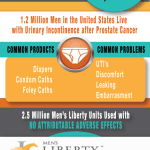Preventive Health: Baby Boomers’ Best Friend
 Preventive Health Checks are the Baby Boomers’ Best Friend
Preventive Health Checks are the Baby Boomers’ Best Friend
It’s Prostate Cancer awareness month and while every cancer can be serious, it’s noteworthy that the survival rate for this disease has clearly improved. Thanks to early diagnosis and treatment, more than 2.5 million men in the U.S. over age 50 are prostate cancer survivors. But the majority of these men face another ongoing, personal challenge: managing urinary incontinence. This article discusses the pros and cons of available options.
According to the American Cancer Society, approximately 233,000 men will be diagnosed with prostate cancer this year. In fact, it’s the second leading cause of cancer death in American men, behind only lung cancer. These numbers are particularly concerning to baby boomers. While about one man in seven will be diagnosed with prostate cancer during his lifetime, diagnosis is most likely to occur after age 65.
Radiation and surgery are common choices for curing prostate cancer if it is not thought to have spread outside the gland. A radical prostatectomy is where the surgeon removes the entire prostate gland plus some tissue around it. Almost all patients experience post-surgery urinary incontinence. In fact, 70 percent of respondents in a 2014 patient survey identified urinary incontinence as the side effect they were most concerned about prior to treatment. Post-surgical surveys indicate that up to 46 percent of prostate cancer survivors report ongoing urinary incontinence issues—from occasional leakage to near-constant dribbles and leaks to complete loss of bladder control.
Treating Common Survivor Effect: Urinary Incontinence
As men get older, chances are they will experience incontinence whether or not they’ve had prostate cancer. The good news is that there are options for treating male urinary incontinence. The bad news is that with the exception of the external catheter, the care options haven’t improved much in the last 50 years.
- Absorbents—pads and diapers—absorb urine and hold the moisture inside, preventing leaks. They are readily available and easy to use, but can reach $4,400 in annual cost to the patient since they are not generally covered by insurance. In as little as five days of continuous use, up to 25 percent of patients develop Incontinence-Associated Dermatitis. In addition, continuous use of absorbents is associated with an increased risk of pressure ulcers.
- The Foley indwelling catheter is accompanied by many negative side effects, including catheter-associated urinary tract infections (CAUTIs), which account for at least 40 percent of all infections acquired in hospitals. The risk of developing a CAUTI increases 5 percent each day a catheter is in place, with a 100 percent infection rate for long-term use. In addition, individuals who use an indwelling catheter for 10 years or more are nearly 5 times as likely to develop bladder cancer.
- Condom catheters, which seal to the shaft of the penis using an aggressive acrylic adhesive similar to duct tape, soak the penis in urine, increasing the likelihood of skin breakdown and UTIs. Up to 15 percent of users will experience skin breakdown, and 40 percent of long-term users will get a UTI. They frequently dislodge and cause great embarrassment.
Safest, Easiest to Use: External Catheter
Most male external catheters can be applied just once a day, unlike condom catheters and adult diapers that typically require multiple daily changes and can result in rashes, sores and infection. They also appear to be the safest, healthiest way to manage men’s urinary incontinence.
Joseph Vercellone, a prostate cancer survivor who doesn’t let urinary incontinence get in the way of his golf game, prefers Men’s Liberty external catheters. In fact, he was playing the Medal of Honor Course at Quantico Marine Base with two buddies when he aced the 14th hole.
Explaining why he believes his success on the 127-yard, par-three hole was due largely to his external catheter, he said, “I contemplated emptying my leg bag as I approached the hole since it was weighing down my left leg, but decided to wait. I’d been told to keep my left foot planted when teeing off, and I think the weight of the bag did the trick.”
Joseph added that it is easy to use and it keeps his golf game moving along without having to make frequent stops. “Hopefully, the PGA won’t deem this use of unauthorized equipment,” he joked.
Sarah Woodward is responsible for executing key research studies at BioDerm Inc., providing valuable industry insights that improve patient outcomes and the overall landscape of incontinence care. In addition, she has been a caregiver for over ten years, making her very familiar with the challenges they face. BioDerm, with 15 patents and patents pending, manufactures urology, skin interface and catheter securement products made from its own proprietary hydrocolloid that is hypoallergenic, latex free, and moves like a second skin. With more than 2.5 million devices used, there have been zero attributable adverse events. For more information call 800-814-3174, email CustomerCare@MensLiberty.com, or visit www.bioderminc.com.
Category: Wellness



































